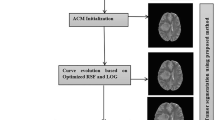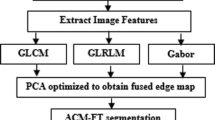Abstract
Accurate brain tumor segmentation from magnetic resonance imaging (MRI) images is important for proper medication. Manual segmentation may be erroneous and a computer-aided method is recommended for precise segmentation which is also challenging due to the contrast level of MRI images. This research work proposes to utilize a parametric active contour model (PACM)-based deformable snake model to segment brain tumors from MRI images. Conventional PACM model prerequisites some initial points for its initialization which may have a time-consuming issue. The main contribution of this paper is to modify the PACM algorithm, so that it can predict its initial points around the region of interest (ROI) from the given minimum (at least three) initial points. This proposed method aids PACM to find the initial contour points automatically to start the deformable mechanism. Furthermore, different parameters of the PACM algorithm are optimized for the segmentation by check and trial method. The proposed method is applied to different shapes of brain tumors inside the MRI images and found satisfactory segmentation outcomes. Furthermore, the proposed algorithm reports the number of total pixels inside the segmented area. Therefore, we hope that this proposal will help to find the area of critically shaped brain tumor in an MRI image.





Similar content being viewed by others
Explore related subjects
Discover the latest articles, news and stories from top researchers in related subjects.References
Ahmmed, R., Rahman, M.A., Hossain, M.F.: An advanced algorithm combining SVM and ANN classifiers to categorize tumors with position from brain MRI images. Adv. Sci. Technol. Eng. Syst. J. 3(2), 40–48 (2018). https://doi.org/10.25046/aj030205
Tandel, G.S., Biswas, M., Kakde, O.G., et al.: A review on a deep learning perspective in brain cancer classification. Cancers (Basel) (2019). https://doi.org/10.3390/cancers11010111
Bi, W.L., Hosny, A., Schabath, M.B., et al.: Artificial intelligence in cancer imaging: clinical challenges and applications. CA Cancer J. Clin. 69(2), 127–157 (2019). https://doi.org/10.3322/caac.21552
Kostka, J.E.A.L.: A review of the medical image segmentation algorithms. In: Peng, S.L., Dey, N., Bundele, M. (eds.) Computing and Network Sustainability. Lecture Notes in Networks and Systems, vol. 75. Springer, Singapore (2019)
Jiang, H., He, B., Fang, D., Ma, Z., Yang, B., Zhang, L.: A region growing vessel segmentation algorithm based on spectrum information. Comput. Math. Methods Med. (2013). https://doi.org/10.1155/2013/743870
Narkbuakaew, W., Nagahashi, H., Aoki, K., Kubota, Y.: Integration of modified K-means clustering and morphological operations for multi-organ segmentation in CT liver-images. Recent Adv. Biomed. Chem. Eng. Mater. Sci. 59, 34–39 (2014)
Sulaiman, S.N., Mat Isa, N.A.: Adaptive fuzzy-K-means clustering algorithm for image segmentation. IEEE Trans. Consum. Electron. 56(4), 2661–2668 (2010). https://doi.org/10.1109/TCE.2010.5681154
Sun, L., Zhang, S., Chen, H., Luo, L.: Brain tumor segmentation and survival prediction using multimodal MRI scans with deep learning. Front. Neurosci. 13(810), 1–9 (2019)
Ahmmed, R., Rahman, M. A., Hossain, M. F.: Fuzzy logic based algorithm to classify tumor categories with position from brain MRI images. In: 3rd International Conference on Electrical Information and Communication Technology (EICT), 7–9 December 2017, KUET, Khulna, Bangladesh (2017)
Lu, Y., Radau, P., Connelly, K., Dick, A., Wright, G.A.: Segmentation of left ventricle in cardiac cine MRI: an automatic image-driven method. In: Ayache, N., Delingette, H., Sermesant, M. (eds.) Functional Imaging and Modeling of the Heart. Lecture Notes in Computer Science, vol. 5528. Springer, Berlin (2009)
Huang, S., Liu, J., Lee, C.L., Venkatesh, K.S., Teo, S.L.L., et al.: An image-based comprehensive approach for automatic segmentation of left ventricle from cardiac short axis cine MR images. J. Digit. Imaging 24, 598–608 (2011)
Hu, H., Liu, H., Gao, Z., Huang, L.: Hybrid segmentation of left ventricle in cardiac MRI using Gaussian-mixture model and region restricted dynamic programming. Magn. Reson. Imaging 31, 575–584 (2013)
Dakua, P.S.: LV segmentation using stochastic resonance and evolutionary cellular automata. Int. J. Pattern Recognit. Artif. Intell. 29, 1–26 (2015)
Wang, L., Pei, M., Codella, F.C.N., et al.: Left ventricle: fully automated segmentation based on spatio-temporal continuity and myocardium information in cine cardiac magnetic resonance imaging (LV-FAST). Biomed. Res. Int. 36758, 1–9 (2015)
Sanchez-ortiz, I. G.: Medical image computing and computer-assisted intervention-MICCAI’99.1679, (1999)
Suinesiaputra, A., Cowan, R.B., Finn, P.J., et al.: Left ventricular segmentation challenge from cardiac MRI: a collation study. In: Camara, O. (ed.) Statistical Atlases and Computational Models of the Heart. Imaging and Modelling Challenges. Lecture Notes in Computer Science, vol. 7085, pp. 88–97. Springer, New York (2012)
Lebenberg, J., Lalande, A., Clarysse, P., Buvat, I., Casta, C., et al.: Improved estimation of cardiac function parameters using a combination of independent automated segmentation results in cardiovascular magnetic resonance imaging. PLoS ONE 10, e0135715 (2015)
Noman, M. A., Hossain, A. B. M. A., Rahman, M. A.: Initial point prediction based parametric active contour model for left ventricle segmentation of CMRI images. In: International Joint Conference on Computational Intelligence (IJCCI), 14–15 December 2018, Daffodil International University, Dhaka, Bangladesh. pp. 1–06 (2018)
Cheng, K., Xiao, T., Chen, Q., Wang, Y.: Image segmentation using active contours with modified convolutional virtual electric field external force with an edge-stopping function. PLoS ONE 15(3), e0230581 (2020). https://doi.org/10.1371/journal.pone.0230581
Li, G., Li, H.: Robust evolution method of active contour models and application in segmentation of image sequence. J. Electr. Comput. Eng. (2018). https://doi.org/10.1155/2018/3493070
Mostaar, A., Houshyari, M., Badieyan, S.: Novel active contour model for MRI brain segmentation used in radiotherapy treatment planning. Electron. Phys. 8(5), 2443–2451 (2016). https://doi.org/10.19082/2443
Rabeh, A.B., Benzarti, F., Amiri, H.: Segmentation of brain MRI using active contour model. Int. J. Imaging Syst. Technol. (2017). https://doi.org/10.1002/ima.22205
Hasan, A.M., Meziane, F., Aspin, R., Jalab, H.A.: Segmentation of brain tumors in MRI images using three-dimensional active contour without edge. Symmetry (2016). https://doi.org/10.3390/sym8110132
Zawish, M., Siyal, A. A., Ahmed, K., Khalil, A., Memon, S.: Brain tumor segmentation in MRI images using Chan-Vese technique in MATLAB. In: International Conference on Computing, Electronic and Electrical Engineering (ICE Cube), Quetta, 2018, pp. 1–6, (2018). https://doi.org/10.1109/ICECUBE.2018.8610987
Widodo, C.E., Adi, K., Sugiharto, A., Maulana, Q., Pamungkas, A.: Volume target delineation for brain tumor in MRI images using active contour segmentation method. Int. J. Appl. Eng. Res. 11(16), 9031–9036 (2016)
Hsiao, P. Y., Chou, S. S., Huang, F. C.: Generic 2-D Gaussian smoothing filter for noisy image processing. In: TENCON 2007–2007 IEEE Region 10 Conference, Taipei, 2007, pp. 1–4. (2007). https://doi.org/10.1109/TENCON.2007.4428941.
Zhu, Y., Huang, C.: An improved median filtering algorithm for image noise reduction. Phys. Proced. Int. Conf. Solid State Devices Mater. Sci. 25, 609–616 (2012). https://doi.org/10.1016/j.phpro.2012.03.133
Kass, M., Witkin, A., Terzopoulos, D.: Snakes: active contour model. Int. J. Comput. Vis. 1, 321–331 (1988)
Kumar, R.: Snakes: active contour models. MATLAB Central File Exchange. https://www.mathworks.com/matlabcentral/fileexchange/28109-snakes-active-contour-models?focused=5156463&tab=function. (2010)
Acknowledgements
The authors would like to thank Rasel Ahmmed, Dept. of ECE, Bangabandhu Sheikh Mujibur Rahman Science and Technology University, and Md. Asadur Rahman, PhD, Dept. of Biomedical Engineering, Military Institute of Science and Technology (MIST) for their different guidelines to conduct this research work.
Funding
The authors got no financial aids from any organization for this research work.
Author information
Authors and Affiliations
Corresponding author
Additional information
Publisher's Note
Springer Nature remains neutral with regard to jurisdictional claims in published maps and institutional affiliations.
Rights and permissions
About this article
Cite this article
Islam, M.M., Kashem, M.A. Parametric active contour model-based tumor area segmentation from brain MRI images using minimum initial points. Iran J Comput Sci 4, 125–132 (2021). https://doi.org/10.1007/s42044-020-00078-8
Received:
Accepted:
Published:
Issue Date:
DOI: https://doi.org/10.1007/s42044-020-00078-8




